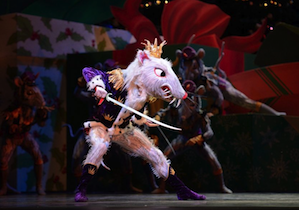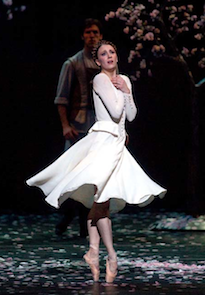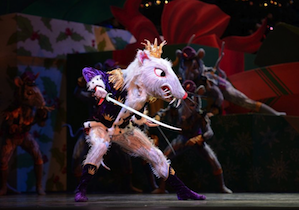
Photo by Erik Tomasson
In the year San Francisco Ballet first performed Nutcracker, Franklin D. Roosevelt won reelection over Thomas E. Dewey, becoming the only U.S. president elected to a fourth term.
Yes, it was that long ago, Willam Christensen choreographing S.F. Ballet's 1944 American premiere of the 1892 Petipa-Ivanov ballet to Tchaikovsky's most popular music.
As one-third of the Sunday matinee's audience of 3,200 around me in the War Memorial appeared not yet qualified for preteen designation (9 to 12), they are certainly excused from the historical quiz. But I wonder how many of the grownups, paying for the tickets, realized the size and importance of the economic-educational juggernaut of which they are now part.
Popular as it is around the world, there is no match for the work’s ubiquity in the U.S. Some 800 productions take place annually in more than 120 cities. In San Francisco, the Nutcracker season consists of 31 performances, drawing an audience close to 100,000 and providing S.F. Ballet with income in the millions.
It is also the first ballet (or theater) experience for thousands of children, providing that all-important initial impetus for the love of performing arts.

Photo by Rosalie O'Connor
Helgi Tomasson's production placing Nutcracker in San Francisco is now 9 years old, and it's still charming audiences. Michael Yeargan’s scenery, set during the 1915 World’s Fair, and Martin Pakledinaz’s sumptuous costumes elicited oohs and aahs, especially in the battle between the mice and toy soldiers, the growing Christmas tree, and the huge blizzard virtually hiding the dancing Snowflakes.
Those with long memories still have trouble with the loss of the sumptuous Candyland in the previous production, replaced by an empty stage; the bland Waltz of the Flowers; and especially, the loss of the growing Christmas tree magic. What was a slow, leisurely growth of the tree to an improbable height, with a great musical-stagecraft climax invoking an ovation, now is a hurried affair, with the battle with the mice errupting suddenly, attention diverted from the tree.
Against those objections, there are many pluses, especially in what Nutcracker is all about: the dancing.
Beginning with Ricardo Bustamante's busy and graceful Drosselmeyer, the first act is notable for the dancing dolls of Dustin Spero, Koto Ishihara, and Hansuke Yamamoto, Davit Karapetyan's mighty Nutcracker Prince making his first appearance, and the Snow Queen and King of Dores André and Luke Ingham.
In the second act, Simone Messmer's Sugar Plum Fairy makes a lasting impression. A recent San Francisco transplant from the American Ballet Theatre, Messmer has a rather remote stage presence, but her elegance, sculpted body, and impeccable technique are remarkable. Karapetyan comes into his own in the sensational Grand Pas de Deux, partnering the lithe, bravura Mathilde Froustey, who came from the Paris Opera Ballet.
The Ballet School children and Benjamin Stewart were a big hit in what is now called the Madame Du Cirque scene (the original Mother Ginger or Old Mother Hubbard), along with Steven Morse's Russian dance, and Kristina Lind's Arabian dance.
The Tomasson production's ending — return to the sleeping Clara (Catherine Stoehr) whose dream it all was — is superior to the old Nutcracker and its Peter Pan finale. In both cases, however, the raptuous audience reaction have been the same. There are brand-new balletomanes enjoying their first ovation.

